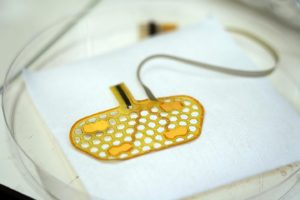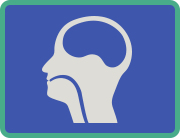Telehealth/Wearable Sensors Studies
The aim of telehealth is to enhance health care delivery in situations where face-to-face modalities or local experts are not available.
Our laboratory is one of the first research laboratories in the US that investigates the development and use of telehealth applications in the management of dysphagia.

Specifically, our initial research in this area (led by Dr. Malandraki's doctoral mentor, Dr. Adrienne Perlman) provided the first evidence that tele-fluoroscopic swallowing studies (that is, real-time swallowing x-ray studies conducted through the Internet) can be a reliable method for evaluating swallowing function when face-to-face assessment is not an option (PI: Perlman, NIDCD R01) (Malandraki et al. 2011). We have since provided further evidence for the support of the use of asynchronous (store-and-forward) telehealth applications in performing dysphagia tele-consultations to improve quality of care in settings where an expert swallowing specialist is not available (Malandraki et al. 2013). Recently our team also showed that clinical swallowing evaluations via telehealth for children with cerebral palsy are feasible and reliable (Kantarcigil et al. 2016).
Wearable Sensors Studies
We are currently exploring the development and use of innovative wearable technology in the evaluation and treatment of dysphagia from a distance.
Our current "wearable sensors study" is examining the development and use of novel wearable electromyographic sensors in the evaluation of swallowing. This study has been funded by the Purdue Institute for Integrative Neuroscience (PIIN)and by the prestigious Ralph W. and Grace M. Showalter Research Trust Award.
In our most recent publication, we presented the development and preliminary validation of our current wearable sensor patch that fits on the curvature of the submental (under the chin) area noninvasively and provides simultaneous remote monitoring of muscle activity and laryngeal movement during swallowing tasks (Kim et al., 2019). This sensor patch is developed to be easy to use, reusable, and cost-effective. This preliminary study demonstrated the effectiveness of this system on a patient with Parkinson's disease and dysphagia, and on a healthy control participant.
For more information on this study and on how to participate (if you qualify), please see our Telehealth Study flyers below or contact us at swallowinglab@purdue.edu. We are actively recruiting for this study!

Collaborators
- Adrienne Perlman
- Serafim Nanas
- Voula C. Georgopoulos
- Vasiliki Markaki
- Jaime Bauer Malandraki
Students/trainees involved in these studies
- Cagla Kantarcigil
- Min Ku Kim
Funding provided by:
- NIH-NIBIB Trailblazer R21 Grant [co-PIs: Lee & Malandraki]
- Purdue Research Foundation Trask Innovation Fund [co-PIs: Lee & Malandraki]
- SMART Consortium [co-PIs: Boudouris, Lee & Malandraki]
- Ralph W. and Grace M. Showalter Research Trust [co-PIs: Lee & Malandraki]
- Purdue Institute for Integrative Neuroscience
- Indiana Lions McKinney Outreach Program
- Patricia Cluss Donation Fund
- National Institutes of Health / National Institute of Deafness and Communication Disorders [R01, PI: Perlman]










